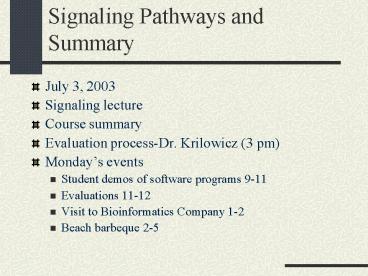Signaling Pathways and Summary PowerPoint PPT Presentation
1 / 18
Title: Signaling Pathways and Summary
1
Signaling Pathways and Summary
- July 3, 2003
- Signaling lecture
- Course summary
- Evaluation process-Dr. Krilowicz (3 pm)
- Mondays events
- Student demos of software programs 9-11
- Evaluations 11-12
- Visit to Bioinformatics Company 1-2
- Beach barbeque 2-5
2
What is signal transduction?
- Conversion of a signal from one physical or
chemical form into another. - In cell biology, commonly refers to the
sequential process initiated by binding of an
extracellular signal to a receptor and
culminating in one or more specific cellular
responses.
3
What is a signal transduction pathway?
Chemical signals are converted from one type of
signal into another to elicit a molecular
response from the organism. All organisms require
signaling pathways to live.
A?B?C?D?E?F?G
Letters represent chemicals or proteins.
4
What is a second messenger?
- An intracellular signalling molecule whose
concentration increases (or decreases) in
response to binding of an extracellular ligand to
a cell-surface receptor.
5
Seven levels of regulation of cell growth
An unrepaired mutation in a gene for a DNA-repair
protein, a cell-cycle control protein, or and
anti-apoptosis protein can increase the
likelihood of a cancer developing.
6
Signal Transduction Animations
http//kinase.oci.utoronto.ca/Movies/movies.html
7
Database to deal with signaling pathways (still
in development)
http//www.grt.kyushu-u.ac.jp/spad/index.html
8
One project to organize information of
interacting molecules is KEGG
KEGG (Kyoto Encyclopedia of Genes and Genomes) is
a bioinformatics resource for understanding
higher order functional meanings and utilities of
the cell or the organism from its genome
information. The KEGG project is undertaken in
the Bioinformatics Center, Institute for Chemical
Research, Kyoto University with supports from the
Ministry of Education, Culture, Sports, Science
and Technology (MEXT), the Japan Society for the
Promotion of Science (JSPS), and the Japan
Science and Technology Corporation (JST).
9
Databases of KEGG
- Metabolic pathways http//www.genome.ad.jp/kegg/ke
gg2.html - pathway - Regulatory pathways
- Ortholog tables
10
(No Transcript)
11
Goals of SoCalBSI
- 1) Familiarize computer science and molecular
life science students with bioinformatics
software programs - 2) Introduce programming skills that will enable
students to independently write programs - 3) Explore the social, moral and ethical issues
associated with the human genome sequence
- 4) Offer career counseling and expose to career
opportunities - 5) Provide research experiences with professional
bioinformaticists - 6) Create opportunities for interactions with
bioinformaticists - 7) Foster long-lasting professional relationships
12
(No Transcript)
13
Course Summary
- Program Learning Objectives (partial list)
- Retrieve gene sequence information from GenBank
and Protein databases - Use BLAST program to conduct gene similarity
searches - Align multiple sequences with Clustal W program
- Predict protein functional motifs with BLIMPs
- Display and compare 3-D structures of proteins
- Model protein structure using a homologous
structure analysis program (Deep View) - Write algorithms that will perform a simple
search of gene sequences stored in a database - Understand the statistics used in scoring aligned
sequences in common programs. - Appreciate the ethical issues that developed from
sequencing the human genome.
14
List of software programs you should be familiar
with
- PubMed
- Dotter
- Needleman-Wunsch global alignment
- Smith-Waterman local alignment
- BLAST
- FASTA
- Phylip
- Mascot
- ChouFasman
- Kyte-Doolittle
- GOR
- Dotter
- CLUSTAL W
- BLIMPs
- PSIPRED
- DeepView (Swiss PDB viewer)
15
List of databases that we studied
- Online Mendelian Inheritance of Man
- MedLine
- GenBank
- EMBL
- DDBJ
- SWISSPROT
- Protein Information Resource
- ProSite
- BLOCKS
- Protein Data Bank (PDB)
- Swiss 2D Gel
16
Concepts in bioinformatics
- ENTREZ-Suite of connected programs that allow for
analysis of genes and proteins - Modular nature of proteins
- Sliding window
- Alignment methods (Local vs. Global)
- Dynamic programming
- Statistics (E-value, Z-score, Probabilities,
Bayes Theorem)
17
Concepts in bioinformatics II
- Primary and secondary databases
- Similarity vs. identical amino acids
- Scoring matrices (PAM, BLOSUM, PSSM)
- Multiple alignment
- Guide trees
- Neural networks
- Protein structure prediction
- Developing software program that aligns sequences
based on scoring matrices
18
Future of bioinformatics
- Traditionally divided into two camps-users and
developers - SoCalBSI students should have an advantage over
the typical applicant to graduate school or
industry position
- Online Journal of Bioinformatics
- Bio Inform-a newsletter for bioinformaticists

